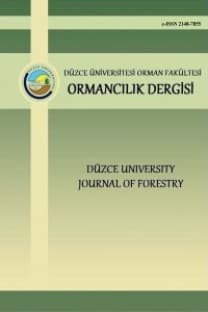Isıl İşlemin Odun Özellikleri Üzerine Etkisi
Tarihe baktığımızda ahşap iğneden kilise inşaatına kadar geniş bir kullanım alanı bulmuştur. Ancak
Anahtar Kelimeler:
Isıl işlem, odun özellikleri, yapışma performansı, biyolojik dayanıklılık
___
- Ayrilmis N, Winandy JE 2009. Effects of Post Heat-Treatment on Surface Characteristics and Adhesive Bonding Performance of Medium Density Fiberboard, Materials and Manufacturing Processes 24(5): 594–599, ISSN: 1042-6914.
- Ayrilmis N, Laufenberg TL, Winandy JE 2009. Dimensional stability and creep behavior of heat-treated exterior medium density fiberboard, European Journal of Wood and Wood Products 67(3): 247-366, ISSN: 0018-3768.
- Banoub JH, Delmas M 2003. JMS letters. Journal of mass spectrometry 38:900-903.
- Boonstra MJ 2008. A two-stage thermal modification of wood. Ph.D. dissertation in cosupervision Ghent University and Université Henry Poincaré - Nancy 1, 297 p. ISBN 978-90-5989-210-1.
- Brunow, G 2001. In: Lignin, Humic Substances and Coal, M. Hofrichter and A. Steinbuchel, eds., P. 89, Wiley-VHC.
- Davis WH, Thompson WS 1964. Influence of thermal treatments of short duration on the toughness and chemical composition of wood. Forest products journal 14:350-356
- Enjily V, Jones D 2006. The potential for modified materials in the panel products industry, Wood Resources and Panel Properties Conference, COST Action E44/E49, 12-14 June, 2006, Valencia, Spain.
- Fengel D, Wegener G 1989. Wood: Chemistry, Ultrastructure, Reactions. Walter de Gruyter and Co. Berlin-Germany.
- Finnish ThermoWood Association, 2003. Thermowood Handbook, c/o Wood Focus Oy, P.O. Box 284 (Snellmaninkatu 13), FIN-00171 Helsinki, Finland. URL: http://www.thermowood.fi/data.php/200312/795460200312311156_tw_handbook.pd f (31 Dec., 2009).
- Follrich J, Muller U, Gindl W 2006. Effects of thermal modification on the adhesion between spruce wood (Picea abies Karst.) and a thermoplastic polymer, Holz Als Roh-Und Werkstoff 64(5):373–376.
- Goodell, B 2003. Brown-rot fungal degradation of wood: our evolving view. In Wood Deterioration and preservation. Advances in our changing world (by Goodell, Nicholas and Schultz). ACS symposium series 845, American Chemical Society, Washington DC, chapter 6:97-118.
- Hill, CAS 2006. Wood Modification: Chemical, Thermal and Other Processes, Wiley Series in Renewable Resources, John Wiley & Sons Inc., 260 pages, Chichester, UK. ISBN: 978-0-470-02172-9.
- Johansson, D 2005. Strenght and Colour Response of Solid Wood to Heat Treatment, Licentiate Thesis, Luleå University of Technology, Department of Skellefteå Campus, Division of Wood Technology, Skellefteå-Sweden, ISSN 1402-1757 / ISRN LTU-LIC--05/93--SE / NR 2005:93.
- Kamdem DP, Pizzi A, Jermannaud A 2002. Durability of heat-treated wood. Holz als Rohund Werkstoff 60: 1-6.
- Kocaefe D, Poncsak S, Boluk Y 2008. Effect of thermal treatment on the chemical composition and mechanical properties of birch and apsen, BioResources 3(2):517- 537.
- Kocaefe D, Shi LJ, Yang D-Q, Bouazara M 2008. Mechanical properties, dimensional stability, and mold resistance of heat-treated jack pine and apsen, Forest Products Journal 58(6):88-93.
- LeVan SL, Ross RJ, Winandy JE 1990. Effects of Fire Retardant Chemicals on Bending Properties of Wood at Elevated Temperatures, Res. Pap. FPL-RP498, USDA Forest Service Forest Products Laboratory, Madison, WI-USA, 24 pp.
- Nuopponen, M 2005. FT-IR and UV Raman spectroscopic studies on thermal modification of Scots pine wood and its extractable compounds, Doctoral dissertation, Helsinki University of Technology, Department of Forest Products Technology, Laboratory of Forest Products Chemistry, Reports Series A 23, Espoo-Finland.
- Poncsak S, Kocaefe D, Bouazara M, Pichette A 2006. Effect of High Temperature Treatment on the Mechanical Properties of Birch (Betula papyrifera), Wood Science and Technology 40:647-668.
- Sernek, M 2002. Comparative analysis of inactivated wood surfaces, Doctoral Dissertation, Virginia Polytechnic Institute and State University, 179 pages.
- Sernek M, Boonstra M, Pizzi A, Despres A, Gérardin P 2008. Bonding performance of heat treated wood with structural adhesives, European Journal of Wood and Wood Products 66(3): 163-242.
- Stamm, AJ 1964. Wood and Cellulose Science. The Ronald Press Company, 317-320, New York-USA.
- Sjöström, E 1993. Wood Chemistry: Fundamentals and Applications. Second Edition, Academic Press, San Diego-California 92101-4495 USA, 293 p.
- Sundqvist, B 2004. Colour changes and acid formation in wood during heating. Doctoral Thesis, Lulea University of Technology, Skellefteå Campus, Division of Wood Material Science, Skellefteå-Sweden, ISSN 1402-1544 / ISRN LTU-DT--04/10--SE.
- Theander O, Nelson DA 1988. Aqueous, high-temperature transformation of carbohydrates relative to utilization of biomass. In: Tipson RS, Horton D (eds) Advances in carbohydrate chemistry and biochemistry. Academic, Harcourt Brace Jovanovich Publishers, San Diego, pp 273–326.
- Tjeerdsma, FB 2006. Heat treatment of wood- thermal modification-, University of Limerick, Coford Seminar on Wood Modification: Opportunites and Challenges, 9 February 2006, Dublin- Ireland.
- Wikberg, H 2004. Advanced Solid State NMR Spectroscopic Techniques in the Study of Thermally Modified Wood, Academic Dissertation, University of Helsinki, Department of Chemistry, Laboratory of Polymer Chemistry, Helsinki- Finland.
- Winandy JE, Rowell RM 1984. The chemistry of wood strength. In: Rowell (ed) The Chemistry of solid wood. American Chemical Society, Washington, DC. pp.211-256
- Valtion Teknillinen Tutkimuskeskus (VTT), 2001. Reaction mechanisms of modified wood during 10/1999–6/2001, P.O. Box 1000, FI-02044 VTT, Finland.
- Viitaniemi P, Jämsä S, Koskela K, Paajanen L, Vuorinen T, Maunu S, Paakkari T 2002. Reaction mechanisms of modified wood. Finnish Forest Cluster Reseach Programme WOOD WISDOM (1998-2001), Final report. Paavilainen, L. (ed.). Helsinki- Finland., pp.185 – 192.
- ISSN: 2148-7871
- Yayın Aralığı: Yılda 2 Sayı
- Başlangıç: 2005
- Yayıncı: Haldun Müderrisoğlu
Sayıdaki Diğer Makaleler
Üst Yüzey İşlemlerinde Eskitme Teknikleri
Murat Özalp, S.Dündar Sofuoğlu
Karakiriş Dağı (Seben-Nallıhan) Florası
Düzce İli Orman Endüstrisinin Odun Hammaddesi Talebi Üzerine Araştırmalar
Yaşar Selman GÜLTEKİN, Bekir KAYACAN, Kenan OK
Mobilya İşletmesinde Toplam Verimli Bakım Uygulaması
Derya Sevim Korkut, K. Hüseyin Koç
Mısır Saplarından Orta Yoğunlukta Lif Levha Üretimi
Isıl İşlemin Odun Özellikleri Üzerine Etkisi
Süleyman Korkut, Duygu Kocaefe
Peyzaj Aydınlatmasının Algı Üzerine Etkilerinin Düzce Kenti Örneğinde İrdelenmesi
